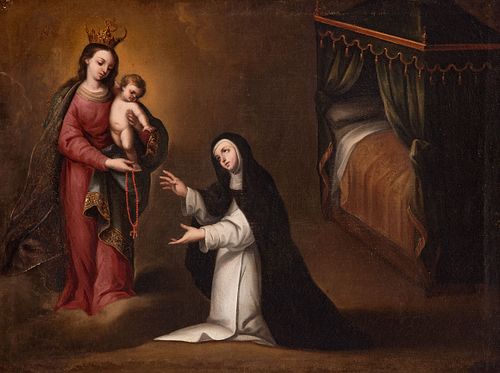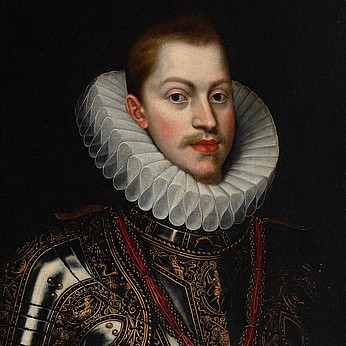JUAN DE SEVILLA ROMERO (Granada, 1643-1695). "Apparition of the Virgin and Child to St. Catherine of Siena". Oil on canvas.
Lot 60
About Seller
Setdart Auction House
Carrer Aragó 346
Barcelona
Spain
Setdart Subastas was born in 2004 and is currently the first online art auction in Spain with solidity, prestige and reliability guaranteed by our more than 60,000 users. Setdart has a young, dynamic and enterprising team ready to successfully manage the purchase and sale of art works through custom...Read more
Estimate:
EUR€4,500 - EUR€5,000
$4,687.50 - $5,208.33
Absentee vs Live bid
Two ways to bid:
- Leave a max absentee bid and the platform will bid on your behalf up to your maximum bid during the live auction.
- Bid live during the auction and your bids will be submitted real-time to the auctioneer.
Bid Increments
| Price | Bid Increment |
|---|---|
| EUR€0 | EUR€10 |
| EUR€200 | EUR€25 |
| EUR€500 | EUR€50 |
| EUR€1,000 | EUR€100 |
| EUR€3,000 | EUR€200 |
| EUR€5,000 | EUR€500 |
| EUR€10,000 | EUR€1,000 |
| EUR€20,000 | EUR€2,000 |
| EUR€50,000 | EUR€5,000 |
About Auction
By Setdart Auction House
Nov 24, 2021
Set Reminder
2021-11-24 09:00:00
2021-11-24 09:00:00
America/New_York
Bidsquare
Bidsquare : Old Masters, Day 1
https://www.bidsquare.com/auctions/setdart-auction-house/old-masters-day-1-7873
Setdart Auction House sofia@setdart.com
Setdart Auction House sofia@setdart.com
- Lot Description
JUAN DE SEVILLA ROMERO (Granada, 1643-1695). "Apparition of the Virgin and Child to St. Catherine of Siena". Oil on canvas. Measurements: 86 x 65,5 cm. Typical of the work of Juan de Sevilla was the representation of interiors where the furniture and the divine, that is to say, where the domestic and the miraculous, harmonize merging in spatial continuity. This is what happens here with the apparition of the Virgin with a break of glory before Saint Catherine, who kneels at her feet. Next to her, a bed with a canopy of velvet drapery. Juan de Sevilla Romero was a Spanish Baroque painter, framed in the Granada school of painting as the most direct continuator of Alonso Cano, along with Pedro Atanasio Bocanegra, with whom he maintained a rival relationship. He trained first with Francisco Alonso Argüello, then with Pedro de Moya, and went on to work with Alonso Cano from 1660. The influence of his master and Flemish engravings, especially Rubens, are the fundamental characteristics of his painting. From 1674 he received numerous commissions for the different churches and convents of his city, such as the two canvases of the sacristy of the convent of San Jerónimo (in situ), San Pantaleón for San Felipe Neri (Museo de Bellas Artes de Granada), Triunfo de la Eucaristía for the Augustinian nuns (in situ) and Los discípulos de Emaús del Hospital del Refugio y convento de San Antón de Granada, among others. He also worked in Cordoba and Seville, where he collaborated in the tempera decorations for the Corpus Christi celebrations. Other conserved works of his are The Holy Family (Museum of the Passion, Valladolid), the Pietà (cathedral of Seville), the Santas (National Museum of Poznam, Poland) and Presentation of the Virgin in the Temple and The Rich Epulon and the Poor Lazarus (Prado, the first coming from the royal collections and the second acquired in 1928).
- Shipping Info
-
In-house shipping available. Please inquire at admin@setdart.com.
-
- Buyer's Premium



 EUR
EUR CAD
CAD AUD
AUD GBP
GBP MXN
MXN HKD
HKD CNY
CNY MYR
MYR SEK
SEK SGD
SGD CHF
CHF THB
THB

















